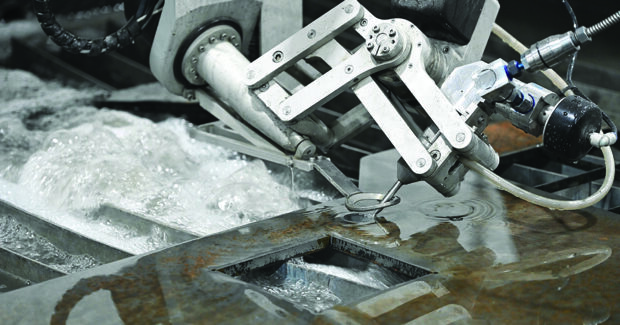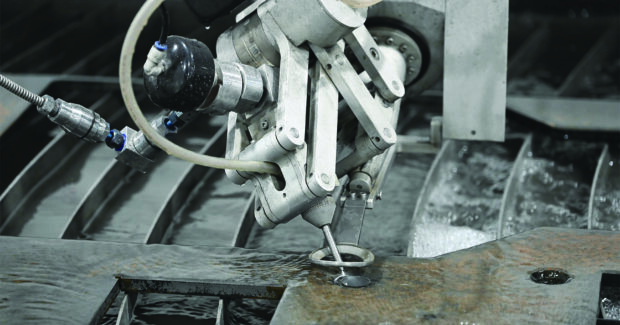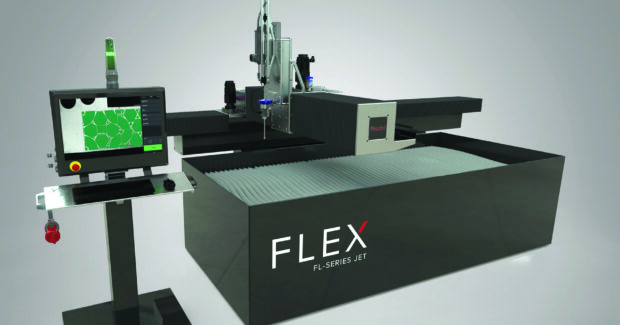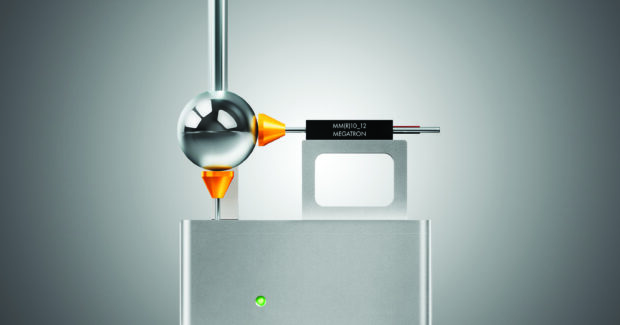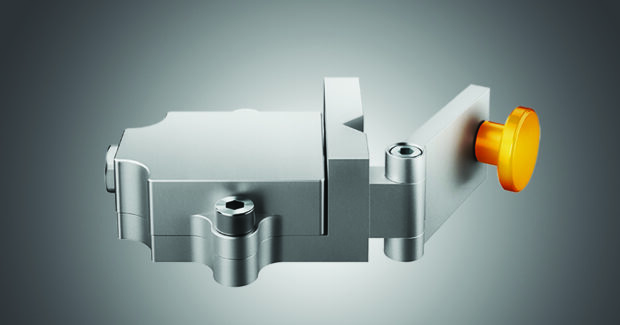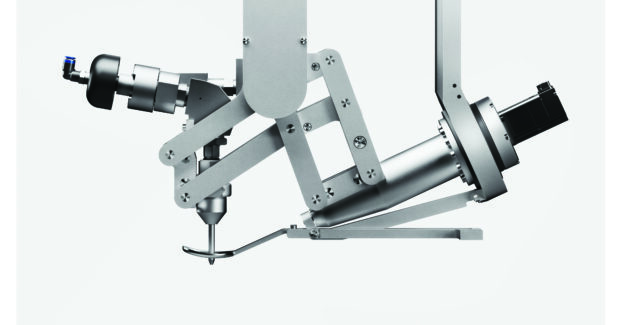A Primer: Understanding the Technology and Benefits of Waterjet Cutting
Due to their flexibility, precision, edge finishes, eco-friendliness and more, waterjet systems are gaining popularity as one of the top technologies for cutting.
Posted: September 30, 2024

Waterjet cutting is a manufacturing process that uses highly pressurized water, sometimes with an abrasive, for an accelerated eroding process that can cut and shape a wide range of materials. Due to their flexibility, precision, edge finishes, eco-friendliness and more, waterjet systems are gaining popularity as one of the top technologies for cutting. The following primer reviews what waterjet cutting is and how it can benefit your cutting applications.
Waterjet Technology Explained
- Generating Pressure: The specialized pump system generates pressure to move the water into the machine — that pressure can measure up to 90,000 psi on some waterjets. For reference, atmospheric pressure, or the force of air pushing down on Earth, is only 14.7 psi at sea level. This amplified water is fed through stainless steel high-pressure tubing into the cutting head, which will further increase its velocity for fast, efficient cutting.
- Going Through the Orifice: Water is tapered into the orifice, which returns lost velocity to the water after traveling from the pump to the head. The orifice is a small chip with a small hole in the center, most commonly made of synthetic corundum, a material only surpassed in hardness by diamond. These orifices are divided into categories, each affecting the water stream differently. For example, FlexJet waterjet systems from Flex Machine Tools offer the orifices in diamond and sapphire, both of which guarantee longevity under care.
3) The Venturi Effect: The Venturi effect is the drop in pressure as fluid flows through a constricted area of a pipe. As pressure drops, fluid velocity increases. The hole in the orifice is thinner than a human hair, which creates a vacuum that adds velocity and makes the stream more powerful and precise.
4) Introducing an Abrasive: Depending on the waterjet’s function, there are two options: pure water and abrasive. Pure water is just that; if a material can be cut with a knife or scissors, water by itself will cut it. If the material is sturdier, an abrasive is introduced to optimize the erosion process. The standard abrasive is garnet, which is not only abundant on the Earth’s surface but recyclable.
5) Cutting Heads: The type of cutting head will generally depend on the nature of the project. FlexJet, as an example,offers three different options for the cutting head: conventional, Tilter, and 5-axis. The conventional cutting head is for 2D cutting at an angle of ±0°, while the Tilter and 5-axis cut at ±45° and ±70°, respectively, for taper compensation on complex geometries. Each cutting head is specialized for the project, depending on how the material is cut.
6) Cutting the Material: Water and abrasive are shot out of the nozzle to begin a powerful eroding process. The processing time will depend on the material and the project; however, waterjets are built with speed in mind, some offering speeds up to 1,800 inches per minute. The result is highly precise and smooth-edged cuts.
Waterjet Cutting Advantages
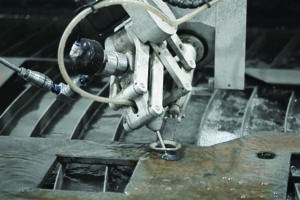 Since there are a range of cutting methods you can consider, it is useful to understand how waterjet compares to laser, plasma, wire EDM, and other cutting methods:
Since there are a range of cutting methods you can consider, it is useful to understand how waterjet compares to laser, plasma, wire EDM, and other cutting methods:
Cold Cutting
Most cutting processes generate heat, which leaves a heat-affected zone on the edges of the part. While this does not lead to melting, it does lead to a change in the material’s properties. Discoloration, heat distortion, and hardened edges can all affect the characteristics of the final part, which will require heat treatment before being put into use.
Waterjet cutting on the other hand, is a cold process. This means there is no need for secondary treatments and no concern about imperfect cuts, weak points, warping, and flaws, which can affect the life of the manufactured product. Waterjet cutting creates less waste with fewer broken parts, leaving smooth, velvety edges that do not require a secondary process to finish.
High Accuracy

Waterjet cutting is highly precise and produces quality products even with challenging specifications. Tolerances can range from 0.075-to-0.125 mm for parts less than one-inch thick. Accuracy depends on factors such as table stability, machine construction, abrasive flow rate, cutting stream control, stream lag, and process error.
Sustainability
Waterjets are energy efficient, produce no hazardous waste, use recyclable materials, and do not require coolants and lubricants. They are highly cost-effective, with the ability to cut multiple parts or materials in one operation without the need for secondary processing.
Compatibility with Different Materials
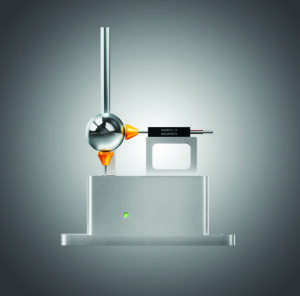
With suitable parameters and abrasives, waterjet cutting can tackle a broader range of materials than any of the alternative methods. For industries dealing with multiple materials, this makes a waterjet ideal for its flexibility and efficiency.
Advancing with Waterjet Automation
For the highest cutting productivity, automated waterjet solutions are now available. Waterjets equipped with an IGEMS CNC control, CAD/CAM software and hardware including the advanced Tilter 5-axis waterjet cutting head, Snapper camera for optimal positioning, Rounder kinematic compensation tool, and Straighter perpendicular angle tool are available from Flex, the only company in the United States offering these capabilities, catering to the intricate needs of diverse materials and cutting requirements, ensuring unparalleled accuracy and efficiency in waterjet cutting processes.
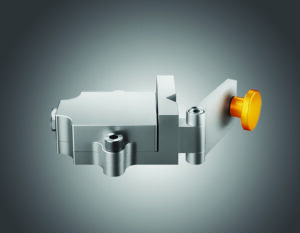
A range of automated technologies includes:
- 45° Bevels & Taper Compensation: The Tilter 5-axis Waterjet Cutting Head provides flawless taper angle compensation and effortless bevels, making it the most versatile and fastest cutting head available.
- Accurate Photos of Cutting Table: The CNC Snapper takes detailed and accurate photos of the cutting table. The image provides the basis for optimal positioning in the NC program, saving time and minimizing material use.
- Precise Calibration: The Rounder Kinematic Compensation Tool quickly, efficiently measures, calculates and compensates for deviation in 5-axis waterjet cutting. Easy-to-use, it only takes 15 minutes to measure multiple positions on your bevel kinematic to account for any mechanical deviation.
- Perpendicular Cutting Tools: The Straighter is a handy and advanced tool that clips onto the machine’s mixing tube. It’s a matter of seconds until the 5-axis kinematic perpendicular angle is as straight as an arrow.
- Precise Calibration: The Rounder Kinematic Compensation Tool quickly, efficiently measures, calculates and compensates for deviation in 5-axis waterjet cutting. Easy-to-use, it only takes 15 minutes to measure multiple positions on your bevel kinematic to account for any mechanical deviation.
Waterjet Applications
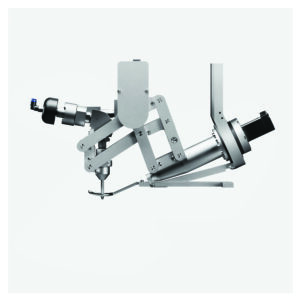
It is interesting to note that waterjet cutting is widely used in various industries for efficient cutting. It is an excellent technology for cutting any metal including titanium, brass, copper, hardened tool steel, aluminum, and other unusual metals. As stated previously, since waterjet cutting does not raise the temperature of the workpiece, its structural and chemical integrity is not compromised, making it very useful in industries where multiple types of metal are needed, or the integrity of the part is essential.
Additional use cases include cutting glass because the waterjet stream only applies pressure where the cut is occurring, so most glass will not shatter with waterjet cutting. Granite, marble, porcelain, stone, and tiles can all be precisely cut using abrasives added to jet-cutting equipment.
What’s more, waterjet cutting is the safest method for cutting polymers because there is no temperature increase during the process. There is also no chance of melting the plastic, ensuring a consistent, uniform cut edge around the part. Ceramics, fabric, rubber, foam and even food processing are all also excellent candidates for waterjet cutting.






